Archives
(PRELIMS Focus)
Category: Polity and Governance
Context:
- The National Commission for Scheduled Castes has prescribed conditions under which complaints to the panel can be rejected — in some cases, without a hearing.
About National Commission for Scheduled Castes (NCSC):
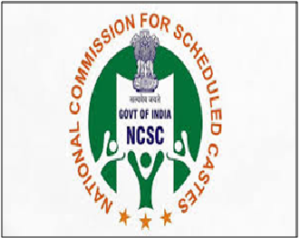
- Nature: The NCSC is a Constitutional Body established with a view to provide safeguards against the exploitation of Scheduled Castes and to promote and protect their social, educational, economic and cultural interests.
- Composition: The NCSC comprises a Chairperson, a Vice-Chairperson, and three additional Members.
- Appointment: These positions are filled through the President’s appointment, indicated by a warrant under his hand and seal.
- Conditions of service: Their conditions of service and tenure of office are also determined by the President.
- Evolution:
- Initially, the constitution provided for the appointment of a Special Officer under Article 338. The special officer was designated as the Commissioner for Scheduled Castes and Scheduled Tribes.
- By 65th Constitutional Amendment Act, 1990, it amended Article 338 of the Constitution and replaced the one-member system with a multi-member National Commission for Scheduled Castes (SC) and Scheduled Tribes(ST).
- Through 89th Constitutional Amendment Act, 2003, Article 338 was amended, and the erstwhile National Commission for SC and ST was replaced by two separate Commissions from the year 2004.
- Powers: The Commission, while investigating any matter or inquiring into any complaint, has all the powers of a civil court trying a suit and in particular in respect of the following matters:
- summoning and enforcing the attendance of any person and examining him on oath;
- receiving evidence on affidavits; and
- requisitioning any public record from any court or office.
- Changes post 2018: Till 2018, the commission was also required to discharge similar functions with regard to the other backward classes (OBCs). It was relieved from this responsibility by the 102nd Amendment Act, 2018.
Source:
Category: Science and Technology
Context:
- Thalassemia patients flagged shortage of leukocyte filter sets and iron chelation drugs in Kerala.
About Thalassemia:
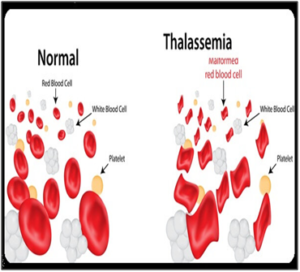
- Nature: Thalassemia is an inherited blood disorder that reduces the body’s ability to produce normal hemoglobin, leading to fewer healthy red blood cells and anemia.
- Cause: Thalassaemia is caused by inheriting a gene mutation (change in the normal DNA) from one or both parents.
- Symptoms: Symptoms range from growth issues, delayed puberty, and bone abnormalities in mild cases to poor appetite, jaundice, dark urine, and facial bone irregularities in severe cases.
- Types of Thalassemia:
- Alpha Thalassemia: It is caused by defective alpha-globin genes inherited from both parents.
- Beta Thalassemia: It is caused by defects in beta-globin genes.
- Treatments:
- Blood transfusions – regular blood transfusions treat and prevent anaemia; in severe cases these are needed around once a month.
- Chelation therapy – treatment with medicine to remove the excess iron from the body that builds up as a result of having regular blood transfusions.
- The only possible cure for thalassaemia is a stem cell or bone marrow transplant, but this is not done very often because of the risks involved.
Source:
Category: Environment and Ecology
Context:
- A report on 25 years of support for wildlife warriors by the Wildlife Trust of India (WTI) has highlighted the role of India’s forest protectors.
About Wildlife Trust of India (WTI):
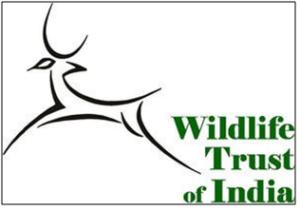
- Nature: The Wildlife Trust of India (WTI) is a non-profit conservation organisation dedicated to safeguarding India’s natural heritage. It is a registered charity in India (under Section 12A of the Income Tax Act, 1961).
- Establishment: It was established in 1998 in response to the numerous crises confronting India’s wildlife and wild habitats.
- Objective: Its mission is to conserve nature, especially endangered species and threatened habitats, in partnership with communities and governments.
- Ministry: It works closely with the Ministry of Environment, Forest and Climate Change under the Government of India, as well as with the respective state government forest and wildlife departments.
- Headquarters: It is headquartered in New Delhi.
- About Van Rakshak Project (VRP):
- The WTI launched the Van Rakshak Project (VRP) in 2000 with the International Fund for Animal Welfare’s (IFAW) support.
- It aimed at building a well-equipped, and motivated force of frontline forest staff across India. The project has supported more than 21,000 personnel nationwide through a diverse range of capacity-strengthening initiatives.
- A key component of the VRP is the Supplementary Accident Assurance Scheme, which offers immediate financial assistance to frontline forest staff in the event of injury or death in the line of duty.
Source:
Category: History and Culture
Context:
- The first season of excavations carried out by the Tamil Nadu State Department of Archaeology (TNSDA) at Thirumalapuram in Tenkasi district has brought to light the presence of Iron Age culture close to the Western Ghats in Tamil Nadu.
More about the findings:
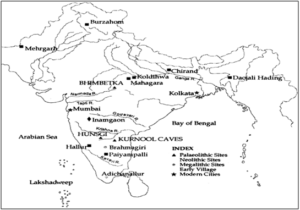
- According to ‘Archaeological Excavations in Tamil Nadu: A Preliminary Report’, the burial site at Thirumalapuram covers nearly 35 acres and lies about 10 km northwest of the present-day village, between two seasonal streams that rise from the Western Ghats near the Kulasegarapereri tank.
- The excavations also yielded a rich collection of ceramics found in graves and among grave goods. These included white-painted black-and-red ware, red ware, red-slipped ware, black-polished ware, and coarse red ware.
- The black-and-red ware, black ware, and black-slipped ware types had white-painted designs, a unique feature first reported from T. Kallupatti and later from Adichanallur, Sivagalai, Thulukkarpatti, and Korkai.
- According to the report, symbols on the urns were among the most striking discoveries at Thirumalapuram. One red-slipped pot featured dotted designs showing a human figure, a mountain, a deer, and a tortoise.
- A total of 78 antiquities made of bone, gold, bronze, and iron were also found. They include a tweezer, sword, spearhead, gold ring, axe, dagger, chisel, bonehead, and arrowhead.
About Iron Age:
- Nature: The Iron Age is a prehistoric period that followed the Bronze Age, characterized by the widespread use of iron for tools, weapons, and other implements.
- Various cultures associated with it:
- Black-and-Red Ware (BRW): It is characterized by distinctive pottery with black interiors and red exteriors due to inverted firing techniques. It is found in Harappan context (Gujarat), Pre-PGW context (northern India), and Megalithic context (southern India).
- Painted Grey Ware (PGW) Culture: It is characterized by grey pottery with black geometric patterns. Iron reported at multiple sites in the Ganga valley and South Indian Megaliths (1st millennium BCE).
- Northern Black Polished Ware (NBPW) Culture: It is characterized by wheel-made pottery which is fine, black, and highly polished. It is significant in north India.
- Megalithic Culture: Megaliths (large stones used to construct a prehistoric structure), linked to iron, are found in the Vindhyas (southern Uttar Pradesh), Vidisha region, and much of South India.
Source:
Category: International Relations
Context:
- Tensions between China and the Philippines over the South China Sea have been rising through the year, particularly over the Scarborough Shoal, a prime fishing ground.
About South-China Sea:
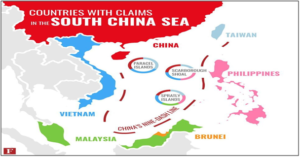
- Location: The South China Sea is an arm of western Pacific Ocean in Southeast Asia. It is south of China, east & south of Vietnam, west of the Philippines and north of the island of Borneo.
- Bordering states & territories: the People’s Republic of China, the Republic of China (Taiwan), the Philippines, Malaysia, Brunei, Indonesia, Singapore and Vietnam.
- Linkage: It is connected by Taiwan Strait with the East China Sea and by Luzon Strait with the Philippine Sea.
- Important islands: It contains numerous shoals, reefs, atolls and islands. The Paracel Islands, the Spratly Islands and the Scarborough Shoal are the most important.
- Significance:
- This sea holds tremendous strategic importance for its location as it is the connecting link between the Indian Ocean and the Pacific Ocean, through Strait of Malacca.
- According to the United Nations Conference on Trade And Development (UNCTAD) one-third of the global shipping passes through it, carrying trillions of trade which makes it a significant geopolitical water body.
- It is believed to have huge oil and gas reserves beneath its seabed.
- It is one of the world’s most heavily trafficked waterways. An estimated USD 3.4 trillion in ship-borne commerce transits the sea each year, including energy supplies to U.S., Japan and South Korea.
- Disputes:
- In the northern part of the SCS, China, Taiwan, and Vietnam contest sovereignty of the Paracel Islands; China has occupied them since 1974. The PRC and Taiwan also claim Pratas Island, which Taiwan controls.
- In the southern part of the sea, China, Taiwan, and Vietnam each claim all of the approximately 200 Spratly Islands, while Brunei, Malaysia, and the Philippines, claim some of them. Vietnam occupies the most land features in the island chain; Taiwan occupies the largest.
- In the eastern part of the sea, China, Taiwan, and the Philippines claim Scarborough Shoal; China has controlled it since 2012.
- China’s “nine-dash line” and Taiwan’s similar “eleven-dash line” overlap with the theoretical 200-nautical-mile (nm) Exclusive Economic Zones (EEZs) that five Southeast Asian countries—Brunei, Indonesia, Malaysia, the Philippines, and Vietnam—could claim from their mainland coasts under the 1994 United Nations Convention on the Law of the Sea (UNCLOS).
Source:
(MAINS Focus)
(GS Paper 3: Indian Economy and issues relating to Growth, Development, and Employment)
Context (Introduction)
As the developed world retreats behind tariff and visa walls, India’s growth strategy — anchored in scale, skill, and self-reliance — presents an outward-looking alternative rooted in domestic capacity-building, global integration, and demographic strength.
India’s Growth Model in a Fragmented World
- Turning Global Protectionism into Opportunity: With rising trade barriers and visa curbs by the US and others, India’s response has been to build internal resilience. The focus on Atmanirbhar Bharat seeks not isolation, but capability — making India a producer and exporter of solutions, not a victim of global walls.
- Demographic Dividend as Strategic Advantage: With a median age under 29, India remains the youngest large economy, in contrast to ageing China and the West. This youthful energy, when matched with Skill India and Startup India, is becoming the foundation of global labour competitiveness.
- Macroeconomic Strength and Consumption Boom: BI forecasts 6.8% GDP growth for FY26, GST revenues consistently cross ₹1.8 lakh crore, and foreign-exchange reserves exceed $700 billion. Festive consumption reached ₹3.7 lakh crore this Dussehra, indicating strong domestic demand and formal credit expansion.
- Investment and Infrastructure Push: Over the past decade, India’s GDP has nearly doubled, exports reached $825 billion, and renewable capacity crossed 220 GW. Record public capital expenditure, stable inflation, and fiscal prudence underline macro stability.
- Digital Public Infrastructure as Competitive Edge: India’s UPI now handles over 650 million daily transactions, surpassing Visa. The JAM trinity — Jan Dhan, Aadhaar, Mobile — alongside ONDC and DigiLocker, showcases how inclusive technology can empower citizens and create globally exportable governance models.
Criticisms and Challenges
- Uneven Employment Generation: Despite strong growth, labour participation and formal job creation lag behind investment trends, necessitating targeted job-rich growth sectors.
- Dependence on Global Markets: Export growth faces headwinds from geopolitical tensions and protectionism, demanding continued diversification of markets.
- Skill Mismatch: The quality and alignment of skilling programmes with global needs remain uneven; India must shift from quantity-based to quality-based skilling.
- Regional and Sectoral Inequalities: Urban–rural and gender divides in access to credit, technology, and employment still hinder inclusive growth.
- Environmental Pressures: Rapid industrial expansion must balance India’s net-zero 2070 commitments through cleaner technologies and circular-economy models.
Reforms and the Road Ahead
- Global Skilling Mission: A unified framework integrating Skill India, Make in India, and Startup India with international certifications and pre-departure training to make Indian workers globally competitive.
- Atmanirbhar Bharat as Global Integration: Promote Make in India for the World — using PLIs, R&D investments, and export-linked manufacturing clusters to build global supply-chain resilience.
- Innovation through Anusandhan Foundation:The ₹50,000 crore Anusandhan National Research Foundation will revitalise India’s R&D ecosystem, linking academia and industry.
- Diaspora as Development Diplomats: With $135 billion remittances in 2024 and 11 Fortune 500 CEOs of Indian origin, India’s diaspora is both a soft-power and economic multiplier.
- Digital and Green Synergy: Expansion of digital infrastructure and renewable capacity will define India’s leadership in sustainable industrialisation and inclusive growth.
Conclusion
When developed nations build walls of protectionism, India builds bridges of capability. Guided by the triad of scale, skill, and self-reliance, India’s model redefines globalization from dependency to confidence. As the 2016 Economic Survey noted, domestic strength is not the opposite of global integration — it is its precondition. India’s next leap, like Hanuman’s in the Ramayana, lies in rediscovering its own power — the belief that national growth and global goodwill are not opposing forces but parallel paths to resilience and renewal.
Mains Question
Q. In an era of rising global protectionism and inward-looking economies, discuss how India can balance its pursuit of self-reliance with the need for global integration.(150 words, 10 marks)
(GS Paper 2: Welfare Schemes for Vulnerable Sections of the Population and Their Implementation; Role of Women and Women’s Organisations in Empowerment)
Context (Introduction)
India’s expanding Direct Benefit Transfer (DBT) ecosystem, powered by the JAM trinity, has enabled millions of women to access formal finance. Yet, the deeper challenge lies in transforming cash access into genuine economic agency and autonomy.
Cash Transfers as a Pathway to Empowerment
- Rise of Gendered Welfare Architecture: States like Bihar (Mukhyamantri Mahila Rojgar Yojana), Karnataka (Gruha Lakshmi), and West Bengal (Lakshmir Bhandar) have positioned cash transfers as instruments of gendered development and political inclusion.
- Formal Financial Inclusion: Over 56 crore Jan Dhan accounts, with 55.7% owned by women, represent a landmark in recognising women as economic actors. According to World Bank’s Global Findex 2025, 89% of Indian women now own a bank account, matching developed nations.
- Enhanced Visibility and Decision-Making: Evidence shows income in women’s names improves intra-household decision-making, child welfare, and spending on nutrition and education — translating welfare into social capital.
- Infrastructure Strength of JAM: The Jan Dhan–Aadhaar–Mobile trinity ensures transparency and targeted delivery, reducing leakages and middlemen. Women benefit from direct transfers linked to unique IDs, fostering dignity and independence.
- Symbolic Recognition of Women as Economic Agents: These schemes mark the first formal acknowledgment of women’s economic identity in policy — shifting from passive beneficiaries to participants in India’s growth story.
| The 2016 Economic Survey highlighted the SEWA pilot on Unconditional Cash Transfers (2011–13) in Madhya Pradesh, where monthly payments were deposited directly into women’s bank accounts.
|
Criticisms and Challenges
- Dormant Accounts and Limited Usage: Nearly 20% of women’s Jan Dhan accounts remain inactive due to insufficient deposits, long distances from bank branches, and discomfort with formal banking.
- Digital Divide and Patriarchal Barriers: Women are 19% less likely to own mobile phones (GSMA 2025), restricting access to UPI, RuPay, and mobile banking. Shared phones compromise privacy and autonomy.
- Low Financial Literacy: More than two-thirds of Indian women rely on male relatives for financial transactions. Lack of confidence and fear of cyber fraud prevent active engagement with financial tools.
- Tokenism Without Agency: Cash transfers, if unaccompanied by structural reforms, risk becoming temporary income support rather than sustained empowerment. The focus must shift from “receiving money” to “using and growing it.”
- Unequal Asset Ownership: Limited access to property, land, or credit reduces women’s ability to convert financial inclusion into productive capital.
Reforms and Way Forward
- Asset-Based Empowerment: Provide joint land titles, secure property rights, and simplified credit to enable women to leverage assets for entrepreneurship and market entry.
- Strengthening the ‘Mobile’ Pillar: Ensure subsidised smartphones and data plans, empowering women to manage accounts independently through digital financial inclusion.
- Gender-Sensitive Financial Products: Banks and fintech firms should design flexible savings and microcredit instruments suited to women’s irregular or seasonal incomes.
- Building Community Confidence: Expand digital banking sakhis, women’s UPI/WhatsApp networks, and peer support groups to increase trust, literacy, and collective problem-solving.
- Representation in Financial Ecosystem: Increase the share of female banking correspondents (currently below 10% of 1.3 million BCs) to enhance outreach, comfort, and reliability for women customers.
Conclusion
India’s gendered cash-transfer model has laid a strong foundation for inclusion, but financial access must evolve into financial agency. Real empowerment arises when women not only receive money but control, invest, and grow it — supported by property rights, digital access, and community networks. The future of India’s welfare economy depends on ensuring that every rupee transferred to a woman’s account strengthens her voice, choice, and control in society.
Mains Question
Q. Critically examine how India can move from welfare-based transfers to sustainable empowerment of women through financial and asset ownership. (250 words, 15 marks)
